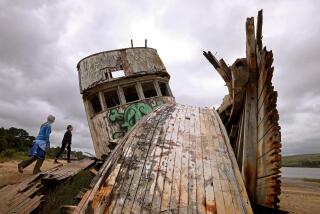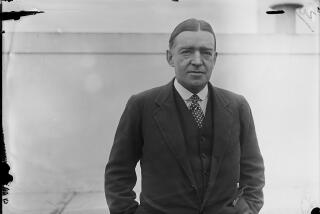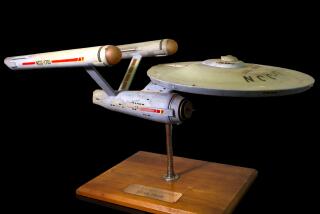DATELINE: NEWPORT NEWS, VA. : Historic Ocean Liner Ends Its Days as Ghost Ship Mired in lawsuits : The United States, once a proud symbol of American supremacy and excellence, now faces an uncertain future and may be sold for scrap metal.
She was the fastest, largest, most luxurious ocean liner America ever built, 12 stories high, five city blocks long, a red, white and blue advertisement for a nation that settled for nothing less than supremacy and excellence.
When she pulled into Le Havre, France, in 1952 on her maiden voyage from New York, 1,700 passengers danced and raised toasts on her decks. The United States had made the transatlantic crossing in a record three days, 10 hours and 40 minutes. The record still stands.
“We worked like monks,” the ship’s navigator, Richard O’Leary, recalled a few years ago. “They had us hyped up to believe we were supermen. On gala nights, you’d be in bed and hear the swish of ball gowns outside your door, smell the perfume, hear the wine glasses clink.”
But the vessel’s golden age lasted only 18 years, and today, two decades and three owners after her last voyage, the United States is a ghost ship, moored at a coal pier in Newport News, the subject of lawsuits and perhaps destined to be turned into scrap in some Asian port.
Facing eviction for unpaid rent, the vessel may move on to Baltimore until its future is settled.
The ship’s owner, United States Cruises Inc., run by Seattle developer Richard Hadley, filed for bankruptcy this month, scuttling the U.S. government’s attempt to auction off the liner on the steps of the federal courthouse in Newport News.
U.S. marshals had taken custody of the vessel in October as a result of a lawsuit against Hadley by CSX Transportation Inc., which owns the coal pier and is owed $225,000 in back rent, but a judge returned the vessel to Hadley last week.
“It’s sad but most of the real interest in the ship has come from parties who would scrap it,” said CSX spokesman Lynn Johnson. “There are people with a passionate interest in the United States because of what it represents, but they are not the people with money.”
In its day, the United States was so fast and her prow so sharp that she once impaled a whale. She sped thousands of passengers, including the Duke and Duchess of Windsor, across the Atlantic, but by 1969, with costs soaring and Boeing 747s symbolizing a new era of jetliner comfort, “The Big U,” as she was known, was cast into retirement after a final voyage to New York.
“We had no idea she was being taken out of service,” said Leroy Alexanderson, the ship’s last captain.
“When the crew was notified, a lot of them left their possessions on board, thinking the ship would come out again soon. We were getting ready for an around-the-world cruise.”
The United States--built for $80 million, half of it federal funds--was sold in 1972 for $12.9 million to the U.S. government, which intended to convert it into a hospital ship for troops. Those plans fizzled, and Hadley bought the pride of America’s maritime fleet in 1981 for $5 million, saying he would spend millions renovating the ship and use it on San Francisco-to-Hawaii cruises.
But short on financing, Hadley auctioned off, for more than $1.6 million, everything that wasn’t bolted down in 1984. The bridge fittings, including two helms wheels and the main binnacle, brought $17,000; triple-plated knives sold for $150 a dozen; eagle-embellished plates, $300 each. Then workmen smashed the porcelain sinks and toilets to get at the nickel-plated traps under the drains.
With no on-deck swimming pool--the United States was designed for heavy-weather travel--and with pipe insulation made of asbestos, it would cost $200 million to transform the ship into a cruise liner, maritime experts say.
Hadley’s attempts to sell time-shares on the vessel, to get German financing and to get a $150-million U.S. government guarantee have all failed. So the United States, rusting and gutted, sways gently alongside the coal pier, the red, white and blue paint on its twin stacks peeling, waiting for eviction or whatever comes next.
“Be an unrushable!” an ad for the great gray ghost once advised. “Take a holiday on the world’s fastest ship.”
A Fabled Past
Facts and figures on the ocean liner the United States
* Narrow enough to fit in Panama canal
* 53,000 tons
* 12 decks
* Made of aluminum
* Maximum speed: 40 knots
* Price: $78 million
Key moments in its history:
* July 3, 1952: Maiden voyage from New York to Bishop’s Rock, Ireland, with 1,700 passengers
* July 7, 1952: Breaks eastbound transatlantic speed record with crossing of 3 days, 10 hours and 40 minutes. Average speed 35.59 knots, 3.9 knots faster than the Queen Mary’s old record.
* November, 1969: Owner halts work during annual refitting and the ship never sails again
One of the five biggest ocean liners
The Norway*: 1035 ft
Queen Elizabeth: 1031
Normandy: 1027
Queen Mary: 1018
United States: 990
* Formerly the France, it is the only one of the ships still sailing
Sources: U.S. Merchant Marine Museum, Passenger Ships of the World
More to Read
Sign up for The Wild
We’ll help you find the best places to hike, bike and run, as well as the perfect silent spots for meditation and yoga.
You may occasionally receive promotional content from the Los Angeles Times.






